Table of Contents
Elephant Nose Fish Care
Elephant nose fish are freshwater fish that require a 50-gallon tank to survive. These are high-maintenance fish requiring high amounts of oxygen, a substrate consisting of sand, and poor lighting conditions. These fish also require mosquito larvae and bloodworms as their primary diet.
Elephant Nose Fish Overview
When looking for a very unusual sea animal for the freshwater home aquarium, elephant nose fish would be an ideal choice. With unique features, Peter’s Elephant, as it is called, is not among common fish often stocked by many hobbyists.
The Elephant Nose Fish is a one-of-a-kind freshwater fish. Their distinct and intriguing appearance sets them apart from other fish. Their owners are sure to delight visitors to their aquarium. We’re not sure if it’s because of their unique appearance or because these fish are so popular. There’s a lot of misinformation about Elephant Nose Fish floating around the internet. Some people describe themselves as small, while others describe themselves as enormous. Others describe them as hostile, while others describe them as serene. It’s undoubtedly pretty perplexing to any potential buyers doing their homework!
So, this guide will help you understand the fish better. I will cover all the details you need about this fish so you can make a sound decision about bringing one home or not. So, let’s get started!
| Information Chart | Elephant Nose Fish |
| Scientific Name: | Gnathonemus petersii |
| Family: | Mormyridae |
| Care Level: | Intermediate |
| Temperament: | Aggressive |
| Color: | Grey, Dark Brown, Black |
| Lifespan: | 6-10 years |
| Size: | 9 inches in length |
| Diet: | Omnivorous bottom feeder |
| Minimum Tank Size: | 50 gallons |
| Temperature: | 73°F to 82°F |
| Water Conditions: | pH: 6-7.2 |
| Tank Mate Compatibility | Selectively Compatible |
Elephant Nose fish Appearance

The Elephant Nose Fish is a stunning fish that resembles a cross between a swordfish and an elephant. They have a long, slender (width-wise) body with some interesting coloring and stripes. Starting at the front, their long snout is slender and droops down a little. This links to their mouth, which is either about eye level or in the middle of their body.
Their heads are slender and pointed, with side-facing eyes. This slope ends around the beginning of their pectoral fin. Their width continues all the way to their dorsal and anal fins. Their dorsal and anal fins are fascinating. They are nearly identical to one another (both in size, color, and pattern). An Elephant Nose Fish’s caudal peduncle is exceedingly tiny in comparison to the rest of its body. It links to a slender forked caudal fin that is mostly black and isn’t very lengthy.
They come in grey or dark brown to black colors. The elephant nose has a long yet trunk-like nose, explaining how it obtained its name. The body is long and thin-like with relatively smooth features. From its side to the rear of the fin are yellowish-white stripes. Most of these fish are about 5 inches or less. But, some grow to be even 9 inches.
This fish has weak eyesight and must direct itself in the water by emitting electrical pulses. These impulses detect and locate objects found underwater. It helps the fish to keep safe underwater and feed.
The Elephant Nose is rather shy and very sensitive. To thrive, it requires pristine water conditions. A hobbyist must therefore test the water to ensure it suits the fish.
In its natural habitat, the fish lives in murky water with low visibility. The Elephant Nose Fish must navigate a multitude of barriers in these rivers to locate food. They’ll have to navigate a maze of roots, logs, branches, and plants to get to their destination. Seems difficult, right?
Their extended “nose” comes very handy in this situation. This protrusion on their skull is called a Schnauzenorgan. It is essentially an all-purpose navigation tool, despite its name (among other things). It’s really sensitive, and it’s linked to their mouth.
This is the Elephant Fish’s principal method of navigating through the murky waters. But, it does more than just allow them to reach out in front of their body while swimming.
This species is an expert in the field of electrolocation. There are different receptors all over its body. Thye can detect small electric currents emitted by other animals. The main portion of their body that uses this is their Schnauzenorgan, and it’s a really useful trick to have.
The Elephant Nose Fish has excellent low-light eyesight. Despite its capacity to detect faint electric emissions from other creatures. This is something that other electric species, such as the Black Ghost Knife Fish, do not have.
As a result of relying on their electroreceptors, fish like these usually end up with a poor vision. This is just another feature that distinguishes the Elephant Nose!
The lifespan of Elephant Nose Fish
The average Elephant Nose fish can live up to six to ten years. The fish will flourish and has the ability to stick around for quite a while if you take good care of them. Providing them with perfect water conditions would help the fish live longer.
Some hobbyists have seen their fish live for more than 10 years.
Elephant Nose Fish Size
The average Elephant Nose fish grows up to 9 inches in length. There have been some instances where the fish has exceeded this number by 2-3 inches. However, this is very uncommon.
Natural Habitat and Origin
The fish is native to Africa, specifically the Congo Basin and Niger. This rare fish species originally inhabited muddy yet dark waters with plenty of plant life. The Elephant Nose is an African freshwater fish with a distinctive appearance. The Niger River, Chari River, and Ogun River are the three major rivers in Africa where these fish can be found. These waters are typically muddy and have poor visibility. This is due to the riverbed and debris that collects in the rivers and the rivers’ relatively gentle current.
They are known to stay in the middle or at the bottom of the seas. Here, they stay put until nighttime when there is darkness.
Elephant Nose Fish Care & Tank Set-Up
Elephant Nose Fish Tank Size and Specifications
Optimum Tank Size for Elephant Nose Fish
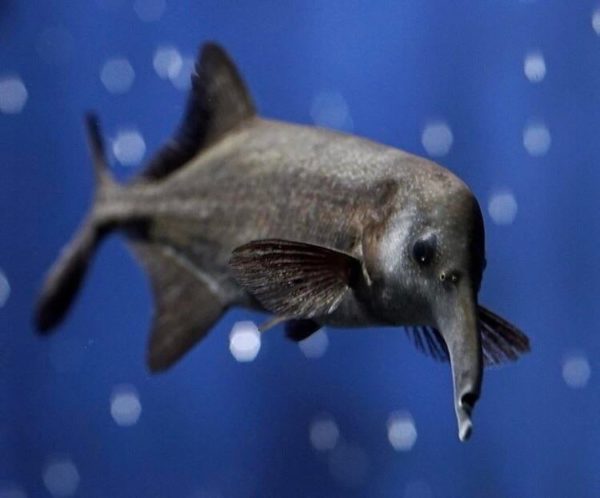
The recommended tank size for Elephant Nose fish is 50 gallons minimum. This assumes you only have one of these fish in your tank. Some web resources suggest that a tank of somewhat less than 50 gallons is enough. However, we strongly advise you to aim for 50. This is a giant fish, so any more space you can provide will be highly appreciated. It will also lessen the chances of hostile conduct. Another advantage of acquiring a bigger tank is putting additional plants and driftwood in it without crowding your fish. This could make a significant impact in lowering stress levels. This would also ensure the species’ long-term survival.
Tank Shape for Elephant Nose Fish
If you keep the size parameters in mind, the shape of the fish tank doesn’t matter. Circular tanks have less space. Hence, it’s always best to use rectangular or square-shaped tanks. These tanks would provide the fish with adequate space to swim around.
Filter type for Elephant Nose Fish
Filtration, on the other hand, is a significant issue that we must address. They’re large fish that can’t stand declining water quality and water movement. They require a lot of oxygen. This leaves you with the choice of an adjustable yet effective canister filter or a sump. Both will almost certainly require a spray bar to keep the flow rate fair while keeping the water clean and oxygenated.
You’ll probably also need an air pump with an airstone to make sure they get enough oxygen.
Substrate for Elephant Nose Fish
Another thing they require is sand. The majority of their natural behavior is reliant on the sand. They forage for food in the sand. They constantly thrust their nose into the sand. Without sand – or with a sharper substrate – they will injure themselves.
It’s pretty cruel to confine them to rocks or pebbles. Not only are they at risk of damaging their proboscis, but they can also contract a bacterial or fungal illness if they are not kept in sand or silt. Soft gravel is essential to prevent the elephant’s nose from hurting its nose. Remember, the nose is quite sensitive and slightly extended. In case something pricks it, an injury might occur. HTH pool filter sand is an excellent substrate. People even use it with Pygmy Corys, and their barbels are long and beautiful!
How many are Elephant Nose fish in a 50-gallon tank?
It’s best to keep these fish in a school of at least 3-4 different species, but 5-7 is much better. In a vast school, the fish feels more at ease and is less likely to show aggression.
As a result, the optimal number of species in a school is 4-7; if you only keep two of them. The alpha male may act aggressively until the weaker fish dies. A 50-gallon tank can house a maximum of two fish, so opt for a bigger tank. This will give you the privilege to house a larger school.
Water Parameters for Elephant Nose fish
Though it survives in water of varying hardness, it thrives best in slightly acidic water or entirely neutral. Its sensitivity to any extreme changes in water conditions makes it a little difficult for beginners. This, however, does not mean that one cannot try.
Larger tanks are a necessity as this fish moves widely. Approximately 2,000 liters of water is the most ideal, more so if the tank is shared with other fish.
Ideal water temperature for Elephant Nose fish
The ideal water temperature for Elephant Nose fish is 73°F to 82°F (the middle of this range is perfect). When it comes to Elephant Nose Fish maintenance, the water conditions will be essential to consider. These fish are susceptible to water conditions. Factors that do not satisfy their baseline requirements can lead to significant health problems.
As the owner, it will be your responsibility to maintain excellent water quality. You should keep the criteria indicated below constant and consistent.
pH Level
The perfect water pH level for Elephant Nose fish is 6-7.2. As the fish is sensitive to changes in water composition, it is not advised for beginner aquarists. It cannot be kept in tanks with varying tank water parameters. Elephant Nose fish, like other ganoid species, is sensitive to most tank chemicals, including salt.
Water Hardness
The fish survives in water with varying hardness. 5 – 15 dKH is the recommended level of hardness for this species. Another thing to keep in mind is that their brain consumes so much oxygen. Hence, they have very high oxygen requirements for a fish that doesn’t like flowing water. So it is advisable to keep the water flow rate and all other water parameters at a consistent level.
The Elephant Nose Fish requires a lot of consistency when it comes to water conditions. It is crucial to do water testing regularly. Invest in a dependable aquarium testing kit that is both high-quality and accurate. This will allow you to make alterations and adjustments confidently. Elephant Nose fish are susceptible to poor water quality; thus, you should perform 25 percent weekly water changes if you have a small tank. If you have a large tank, you can get away with 15 percent or 10% weekly, depending on your setup. As always, ensure your ammonia is 0 ppm, your nitrites are less than five ppm, and your nitrates are less than five ppm. Their tanks are typically quite large. You should probably invest in something like Python. This will changes more accessible and faster. You’ll also be more eager to do them more frequently with one.
Elephant Nose Fish Tank Landscape
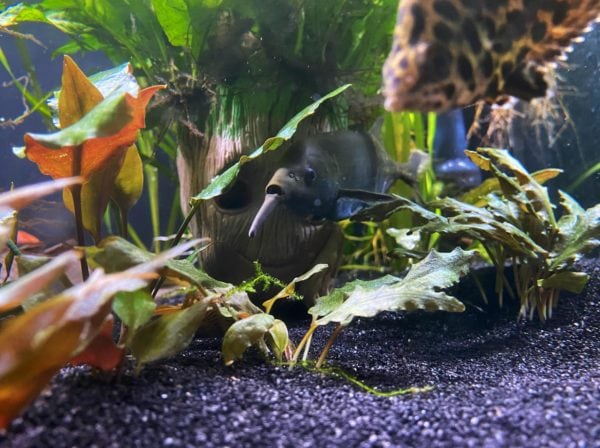
Best Plants for Elephant Nose Fish Tanks
Some good choices include:
- Plants that blot out above light without dense root structures.
- Plants that can handle low light.
- Plants that can grow in sand, on driftwood, or on rocks are all excellent choices.
Fortunately, there are still plenty of cheap and straightforward solutions for your elephants!
Plants like Salvinia, Java Moss, Water Wisteria, Duckweed, Anubias, Java Fern, and Vallisneria are some of the options that you can opt for.
Worst Plants for Elephant Nose Fish Tanks
It is advisable to avoid plants that cannot survive in the water parameters of an Elephant Nose Fish. These plants can die in these water conditions and may even contaminate the water. Other toxic plants that can be hazardous for the aquatic species should be avoided.
Decorations for Elephant Nose Fish Tanks
The tank should be well-planted to provide lots of hiding places for the fish. Pipes and pots in the tank are necessary to reduce the chances of the fish being stressed up. These creatures are from locations where there are a lot of plants. So, you’ll want to include some of those. If you’re going to have an elephant herd, you’ll need plenty of hiding spots for each Elephant Nose. You should also come up with strategies to break up and distribute their area.
Lighting for Elephant Nose fish tanks
Being a shy animal, the Elephant nose fish needs poor lighting conditions. If it is in the tank with other animals, ensure the limited lighting conditions do not disadvantage them. Alternatively, they can be shifted to another well-lit tank. For better comfort, a hollow log with both ends open is a favorite. Remember, they are nocturnal and love darkness more than light. Some hobbyists have discovered that with time the elephant nose fish adjust to well-lit tanks. However, this is only if they share the tank with animals they are comfortable with. If there is no way of evacuating other fishes that dim light may irritate, have more plants around the tank to give them better hiding places.
Feeding Elephant Nose Fish
Best Diet for Elephant Nose Fish
This fish has a unique feeding habit. Just like the elephants do with their trunks, so does the elephant nose fish. It grabs food using a long nose before flicking it inside its mouth. The only difference with the elephant is that its mouth is above the trunk, not below it.
The elephant nose fish can be well fed using Bloodworms, Mosquito Larvae, Black Fly, Brine Shrimp, and Tubifex. Some have been known to consume flake food or even frozen worms. Of course, this may be a bad idea for it at first. Later on, after building trust, it gets comfortable with this diet.
They are slow during feeding time and may not match the competition of other fish in the aquarium. Give it some extra food when other tank mates are less active and are unlikely to offer competition. Do this if only there is enough trust in them to eat from someone’s hands. Some owners have had success in feeding this species pellets and flakes. But this is not particularly common. These fish don’t usually eat these meals. So, if you intended on only feeding them the easy stuff, reconsider!
How often should you feed Elephant Nose fish?
The Elephant Nose fish should typically be fed a few times a day. Check to see if you’re providing them too much or too little. If you cannot devote a significant amount of time to feed them, you should buy an automatic feeder. You will be able to arrange a feeding schedule for them and be stress-free due to this!
Elephant Nose Fish Behaviour and Temperament
Are Elephant Nose fish lone or societal?
When it comes to disposition, the Elephant Nose Fish is a fascinating fish. When these fish are alone, they are usually relatively calm and quiet. They don’t want to get into mischief and prefer to do their own thing!
When kept with another fish of the same species, they might become hostile and territorial. Their typically tranquil temperament will vanish. The more robust fish would almost certainly torture the weaker. This means that their character is highly influenced by the tank mates they have. This is addressed in the following section. Even though they are shy by nature, they have no trouble sharing the aquarium with other fish. So long as they are assisted to feed as other animals rush to get food, they remain comfortable in their environment. Naturally, they are territorial, and when placed with their fellows of the same species, they tend to lean together. Elements of bullying can be sensed when they are two. Three or more is a better number instead.
Elephant Nose Fish Tank Mates
Ideal Elephant Nose fish tank mates
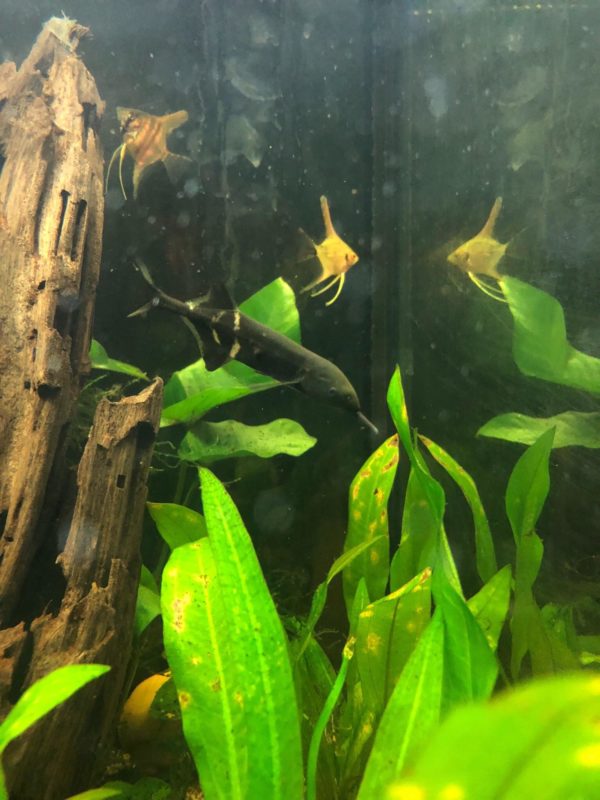
You should make sure that their tank mates are calm. If you want your Elephant Nose Fish to avoid conflict with other species, choose fish with similar personalities. A few good choices: Bichir, Congo Tetra, Cory Catfish, Dwarf Gourami, Sparkling Gourami, Honey Gourami, Pearl Gourami, Angelfish, and Discus.
Bad tank mates for Elephant Nose fish
Avoid keeping it with aggressive tank mates to give it peace. Being a shy animal, bullies tend to stress it up.
Breeding Elephant Nose Fish
Elephant Nose Fish are tough to breed. No records or reports indicate that this species can be produced in a home aquarium.
One of the critical reasons for this is that determining the gender of this species is nearly impossible. Dissection is the only reliable way to do this (which, of course, isn’t an option).
There appears to be an exciting element of disorientation that these fish go through in captivity. This isn’t an issue in the natural habitat. Elephant Nose Fish in captivity have a hard time recognizing one another’s gender.
Breeding Level- Difficult
Elephant Nose fish sexual dimorphism
There had been no successful occurrences of breeding in a tank before today.
As a result, this fish is not bred in captivity. All of the species available for purchase were captured in the wild.
Common diseases and their treatment
This fish is not known to be susceptible to certain disease conditions. However, they are sensitive to most medications. If they share a home with other fishes that need to be regularly treated, the best option is to have them evacuated to another tank.
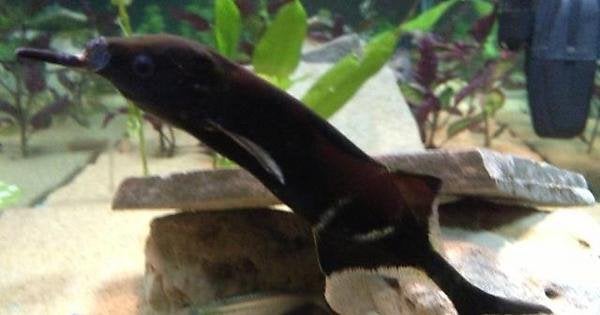
Bacterial Infection
Bacterial infection refers to a group of bacteria that can produce a variety of symptoms. They originate from a variety of sources. In general, you can treat them using a broad-spectrum antimicrobial. It’s usually the diagnosis that’s the most challenging aspect. Fish can have an internal or exterior bacterial infection. This can make things even more difficult.
Symptoms include streaks of red, red ulcers, growths that are fuzzy, popeyes, and bloating. This infection can be caused due to water of poor quality, expired food, unsuitable water conditions, and stress.
Fungal Infection
Fungal infections are challenging because they belong to a large family with a wide range of species. They have a wide range of symptoms. Certain bacterial illnesses also appear suspiciously, like fungi.
If you’re unsure whether your fish has a fungal or bacterial infection, you can treat it with Ich X and Erythromycin (if it’s 100 percent erythromycin). They can be used at the same time. They can assist ensure that you’re treating for both.
Skin & Gill Flukes
Skin and gill flukes are parasitic worms that attach to your fish’s skin and gills. They’re invisible to the human eye. They are challenging to diagnose because they’re so tiny.
Flukes are prevalent in practically every tank. They are entirely safe under normal conditions.
Facts about Elephant Nose Fish:
- Its scientific name is Gnathonemus petersii.
- The fish uses its electrical impulses to find a mate, among other things. This can be distorted in the aquarium, explaining why they rarely breed in captivity.
- Its electrical field is quite hard to sense. You should connect the two electrodes in the aquarium to an amplifier. With this, you can distinguish the clicking sounds the fish makes. It makes this sound when it is when excited or stressed.
- They do jump mighty high. Leaving the tank top open might lead to them getting out and if a cat was nearby. Well, an excellent meal to the cat and a significant loss to the owner.
Are Elephant Nose fish suitable for you?
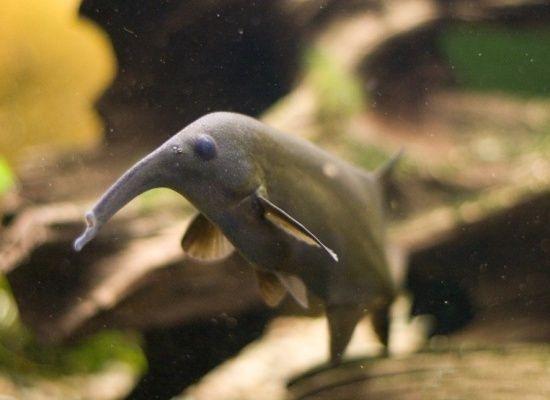
Now that you’ve learned the basics of Elephant Nose Fish care, you can decide if they’re perfect for you. Take some time to consider their specific needs. Make an honest appraisal of your ability to provide them. If you’re a beginner, this isn’t the fish for you. If you’re an experienced fisherman looking for something low-maintenance, this isn’t the fish for you. If you have some experience and want to keep a unique and exciting freshwater critter, the Elephant Nose Fish is an excellent choice. There’s something peculiar about this species that you can’t get used to (in a good way). There’s something strange about this species that you can’t get used to (in a good way). They are distinct from the great majority of other fish. The process of acquiring one will be fascinating for years.
FAQ
Q. Are Elephant Nose Fish Aggressive?
Yes, they can be aggressive. However, their temperament mainly depends on the setup.
Q. Is it challenging to take care of Elephant Nose Fish?
You would need at least an intermediate level of experience when taking care of the Elephant Nose fish.
Q. What are the common names for the Elephant Nose Fish?
Common names for the Elephant nose Fish include Elephant Fish, Dolphin Nose Fish, and Peters Elephant Nose.
Conclusion
This is a once-in-a-lifetime opportunity for you to have these unique but adorable fish in your home aquarium. All you have to do is make sure they have everything they need to live happily. Close the tank with a lid, so they don’t jump out. Yes, these fish are challenging to keep and demand a long-term commitment. But they will repay you handsomely with their loyalty and laid-back attitude.
No related posts.

3 thoughts on “Elephant Nose Fish: Care Guide, Breeding, Tank Size & Disease”
Iam mad and will never buy this fish again. I was not advised when I bought this fish that it was a jumper. I had just purchased it and within 5 min it jumped out
When I see a fish I am thinking if buying, I always look it up before purchase to make sure I can provide its needs. You can’t trust a salesperson making minimum wage to know much about fish. Even if they did, they don’t get paid enough to put up with customers abuse if they dare insinuate someone may not be able to care for a fish.
It is on the purchaser to know about the care, requirements and tendencies of any living creature you plan to take care of.
Fish have personalities and feelings too.
Unusual marks on his side not the stripe at the rear.end I have three in 400lt of water with 4 disc. 1angle and some small fish all the elephant nose eat well